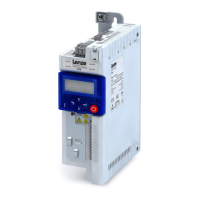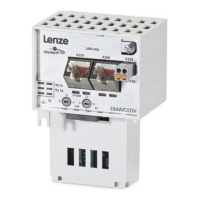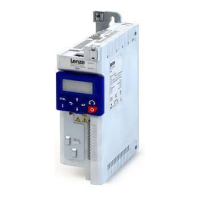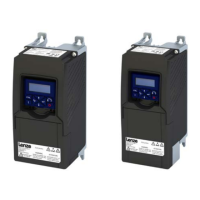6 Function & parameter description
Group 6 – PID setup
84 Lenze · Inverter i510 / i550 - Cabinet · Operation Manual · 0.4 EN · 02/2016
feedback signal.
Example: Booster pump regulated by Pressure. (Increase of Motor speed
results in an increase of the pressure)
Motor can turn only in one direction
2: Reverse operation
Motor needs to increase the speed to decrease the feedback signal.
Example: Cooling water pump regulated by temperature. (Increase of
the cooling pump speed results in a decrease of the temperature.)
Motor can run only in one direction
3: Normal bi-directional
Normal acting mode. Motor can run in both directions.
4: Reverse bi-directional
Reverse acting mode. Motor can run in both directions.
1: Analog input 1
2: Analog input 2
3: DC Bus voltage
4: Motor Current
5: Network
Selection of the PID feedback source
Note: The PID set point and PID Feedback can be different signals!
Defines the % of the inverter output frequency that PID will regulate to.
Example:
P211:0 Max frequency = 50 Hz
P600:3 PID Controlled sped range = 80 %
--> Max calculated PID setpoint 40 Hz
0: No Speed Added
1: Keypad frequency setpoint
2: Analog input 1
3: Analog input 2
4: Preset frequency setpoint 1
5: Preset frequency setpoint 2
6: Preset frequency setpoint 3
7: Preset frequency setpoint 4
8: Network
Selection of Speed feedforward source
PID speed output = Speed feedforward source + PID controlled speed
(Used for Trim control, Dancer control). The line speed (feed-forward)
value is added to the calculated PID output frequency value (see PID
block diagram above).
0.0 ... [5.0] ... 1000.0 %
PID controller P gain
% of max Frequency that results from a 1% PID Error
Example:
PID Error = 20 PUnits
P601:0 P component gain = 2%
P211:0 Maximum frequency = 50Hz
--> PID Output = PID Error * P Gain * (Maximum frequency / 100)
--> PID Output = 10 Hz
PID controller adjustment time Tn
- Value "6000 ms" deactivates the I component.
- With P400:47 the I Part can be disabled

